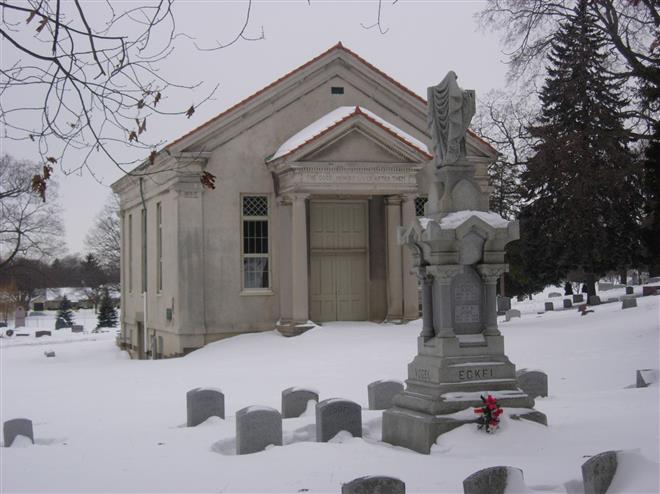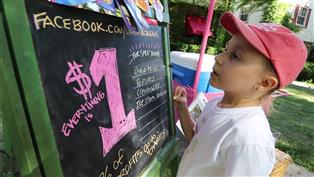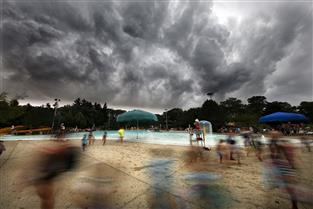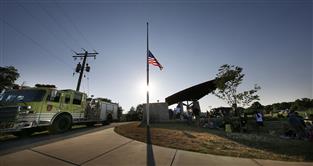Historic Wauwatosa Cemetery eyed for restoration
Two former mayors lead a drive to raise $2 million
For 160 years, Wauwatosa Cemetery has held the remains of the obscure and the famous from the community's past.
Names like Hoyt, Hart, Underwood, Swan and Jacobus — inscribed on headstones on the grounds — are a roll call of the city's history, and are preserved today in street names and park names.
But the cemetery and its chapel need some help. The trustees who oversee the cemetery have launched a $2 million fund drive to restore the chapel, fix the crumbling roads, remove and replace trees, pay off debt, and create a perpetual care fund.
Maricolette Walsh, who was mayor from 1992 to 2000 and is vice president of the cemetery's board of trustees, has made an initial contribution of $16,000 — the balance of her campaign account — to start things off.
Two locations
The current cemetery is just north of Longfellow Middle School on Wauwatosa Avenue.
But the first location of the cemetery, which was organized in 1854, was on a hill overlooking the Village, at what is now the corner of Wauwatosa and Milwaukee avenues, on the site that later became St. Matthew's Lutheran Church.
The cemetery outgrew that site and became too close to the growing business district in the valley.
Minister Enoch Underwood donated land at the present site, and the remains were moved.
The cemetery is still active and has space for more burials, Walsh said. But the chapel "is not usable now, it's a shell," said James Benz, president of the board of trustees. (Benz is another former mayor, having served from 1976 to 1984.)
Chapel's significance
The cemetery's historical importance is enhanced by the presence of the chapel, built in 1852 at the site where the public library is today.
The chapel's congregation was led by Underwood. A noted abolitionist, the minister and his parishioners played a role in the Underground Railroad, protecting runaway slaves from the bounty hunters who chased them. The Underwood family even had a secret closet in their home to hide fugitives, Walsh said.
It was Enoch Underwood's son, Frederick Douglass Underwood, who in 1914 moved the chapel to the cemetery to honor his parents and their friends, the Rev. Luther Clapp, minister of the First Congregational Church, and his wife, according to the cemetery's history.
About half of the $2 million fundraising goal would be spent on restoring the chapel, and another $500,000 on the narrow lanes that loop through the grounds. For the fund drive, the board of trustees is restarting the Wauwatosa Cemetery Foundation, led by a separate body, to receive contributions.
Help from the city
The cemetery has no staff, and burial services and upkeep of the grounds are handled by Hirschfeld Services, a private contractor, said City Finance Director John Ruggini, who himself spends about an hour a month handling financial matters related to the cemetery.
The city also plows the snow, turns the water on and off, and removes fallen trees at the cemetery, said Walsh.
The city's interest in the cemetery's well-being is not just a matter of civic pride. By Wisconsin statute, cemeteries that are abandoned become the responsibility of the municipality in which they are located.
Wauwatosa already has taken on Oak Hill Cemetery, on the north side of Capitol Drive, just east of Highway 45. Ruggini said Oak Hill is full, and is mostly tended by volunteers.
The Wauwatosa Cemetery, of course, is hallowed ground, the way that all cemeteries are, or should be. For Walsh and Benz, it's also a historical site, worthy of restoration.
"We want to bring the chapel building up to the standards of today, so it can be used," Benz said.
More from News and Features
- Anodyne Coffee plans to open location in Wauwatosa Village
- Wauwatosa Meetings: Aug. 4
- Video: Wauwatosa girl's curbside ice cream stand raises money for the hungry
- Wauwatosa News and Notes: Hands-only CPR training offered; Firefly Art Fair is Aug. 6-7
- Wauwatosa Ask Now: Why are there barriers and fencing along the North Avenue bridges over the Menomonee River?
- Mystery Photo Contest: July 28
- Wauwatosa gears up for National Night Out event, this year at the zoo
- Election 2016: Wisconsin's 4th District candidates weigh in
- Wauwatosa's Luther Manor residents share smiles through flower delivery
- Wauwatosa Police Report: July 17-23















